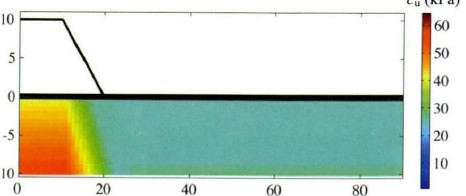A B S T R A C T
High costs are connected with upgrading railway embankments throughout Denmark using the partial factors for geotechnical design calibrated for general application. One way to reduce the costs is reliability-based calibration of the partial factors to a reasonable safety level taking into account the specific design situations and uncertainties relevant to railway embankments. A reliability-based design has been investigated, resulting in an optimal partial factor for the considered subsoil. With a stochastic soil model to simulate the undrained shear strength of soft soil deposits, the partial factor is calibrated using asymptotic sampling for the reliability assessment. The calibration shows that the partial factor can be reduced significantly compared to the value specified in the Danish National Annex to DS/EN 1997-1(2007), Eurocode 7.
1. Introduction
In Denmark, many existing railways are upgraded to higher train velocities and more tracks, leading to increasing demands concerning the structural safety. With the current railway codes, a railway embankment which is upgraded with an extra track must fullfil consequence class CC3 in Eurocode 7 (Banedanmark, 2010). These requirements are expensive, making embankments adequately safe but not excessively safe.
The partial factor in the Danish National Annex to DS/EN 1997-1(2007) has been calibrated for application to a wide range of structures. In Denmark, the partial factor for the undrained shear strength is rather high, y=1.8k, compared to the general factor proposed in Eurocode 7, y一1.41k, where the factor Kn accounts for the severity of the potential failure. Thi引eads the embankment design to become very expensive.
Using the partial factor method (DS/EN 1990, 2007) for specific design of railway embankments, special considerations can be taken into railway design. The partial factor method ensures a certain safety level for the structure, but this level is unknown to the designer since he/she has no influence on the selected partial factors proposed in the Danish National Annex to Eurocode 7.Specifying the partial factor makes it easy for the designer to otroduce safety in the structure, but if the partial factors are not chosen with care, the structure could end up being too safe, and thus very expensive.
Rather than defining a set of partial factors to be used in the design process, a required level of safety could be defined. This will make the design process more complex, but also more flexible allowing the designer to choose a set of partial factors that will ensure the required safety level for the structure. This could be accomplished using probabilistic design of the embankment (Ching et al,2011).Here all parameters are modelled by stochastic variables with a distribution function, a mean value and a standard deviation (koudelka, 2011).
The concept of probabilistic design is presented in the paper.Probabilistic modelling of soil and loads are described, and a sampling technique is provided to minimize calculation time. In the analyses conducted by Lodahl et al. (2012), it was found that the current general demands in the Danish National Annex to Eurocode 7 are too conservative for a railway embankment in cohesive fill situated on soft soils.
The analyses presented are based on the utilization of circular slip surface, and two embankments designed with the optimized partial factor are investigated. Furthermore, modelling with the purpose of estimating the most probable slip surfaces for each of the embankments is carried out.
The analyses are based on a typical situation when upgrading existing railway tracks in Denmark, namely embankments built with cohesive clay fill situated on soft soils, are often peat or gyttja.The embankments are often old, with consolidation effects resulting in harder soils under the embankment than that beside it. In the presented analyses, embankments of different heights, situated ondifferent thicknesses of soft soils, are analysed.
